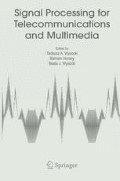Abstract
We present a novel maximum-likelihood (ML) algorithm for joint delay estimation and frame synchronization. The algorithm operates on coded signals and exploits the code properties by accepting soft information from the MAP decoder. Issues of convergence are addressed and we show how computational complexity may be reduced without any performance degradation. Simulation results are presented for convolutional and turbo codes, and are compared to performance results of conventional algorithms both in terms of mean square estimation error (MSEE) and BER. We show that code-aided delay estimation always improves the MSEE, but not necessarily the BER. On the other hand, code-aided frame synchronization is mandatory, in order to avoid either significant BER degradations or the need for very long pilot sequences.
This work has been supported by the Interuniversity Attraction Poles Program P5/11 - Belgian Science Policy.
Access this chapter
Tax calculation will be finalised at checkout
Purchases are for personal use only
Preview
Unable to display preview. Download preview PDF.
References
M. Oerder and H. Meyr. “Digital filter and square timing recovery”. IEEE Trans. on Comm., 36:605–611, May 1988.
J.L. Massey. “Optimum frame synchronization”. IEEE Trans. on Comm., com-20(2): pp. 115–119, April 1972.
C. Herzet, V. Ramon, L. Vandendorpe and M. Moeneclaey. “EM algorithm-based timing synchronization in turbo receivers”. In Proc. International Conference on Acoustics, Speech and Signal Processing (ICASSP), Hong Kong, April 2003.
A.R. Nayak, J.R. Barry and S.W. McLaughlin. “Joint timing recovery and turbo equalization for coded partial response channels”. IEEE Trans. on Magnetics, 38(5):2295–2297, Sept. 2002.
B. Mielczarek and A. Svensson. “Timing error recovery in turbo coded systems on AWGN channels”. IEEE Trans. on Comm., 50(10): pp. 1584–1592, Oct. 2002.
N. Noels, C. Herzet, A. Dejonghe, V. Lottici, H. Steendam, M. Moeneclaey, M. Luise and L. Vandendorpe. “Turbo-synchronization: an EM algorithm approach”. In Proc. IEEE International Conference on Communications (ICC), Anchorage, May 2003.
M.K. Howlader and B.D. Woerner. “Decoder-assisted frame synchronization for packet transmission”. IEEE Journal on Selected Areas in Comm., 19(12): pp. 2331–2345, Dec. 2001.
J. Sodha. “Turbo code frame synchronization”. Signal Processing Journal, Elsevier, 82: pp. 803–809, 2002.
L.R. Bahl, J. Cocke, F. Jelinek and J. Raviv. “Optimal decoding of linear codes for minimising symbol error rate”. IEEE Trans. on Information Theory, 20: pp. 284–287, March 1974.
T.M. Cassaro and C.N. Georhiades. “Frame synchronization for coded systems over AWGN channel”. IEEE Trans. on Comm., 52(3):484–489, March 2004.
H. Wymeersch and M. Moeneclaey. “ML frame synchronization for turbo and LDPC codes”. In Proc. 7th Int. Symp. on DSP and Comm. Systems, Coolangatta, Australia, December 2003.
A.P. Dempster, N.M. Laird and D.B. Rubin. “Maximum likelihood from incomplete data via the EM algorithm”. Journal of the Royal Statistical Society, 39(1): pp. 1–38, 1977. Series B.
P. Robertson. “A generalized frame synchronizer”. In Proc. GLOBECOM, pages 365–369, Dec. 1992.
G. Caire, G. Taricco and E. Biglieri. “Bit-interleaved coded modulation”. IEEE Trans. on Information Theory, 44:927–946, May 1998.
N.A. D’Andrea, U. Mengali and R. Reggiannini. “The modified Cramer-Rao bound and its applications to synchronization problems”. IEEE Trans. on Comm., 42:1391–1399, March 1994.
U. Mengali, R. Pellizzoni and A. Spalvieri. “Soft-decision-based node synchronization for Viterbi decoders”. IEEE Trans. on Comm., 43(9):2532–2539, Sept. 1995.
Author information
Authors and Affiliations
Editor information
Editors and Affiliations
Rights and permissions
Copyright information
© 2005 Springer Science + Business Media, Inc.
About this chapter
Cite this chapter
Wymeersch, H., Moeneclaey, M. (2005). Code-Aided ML Joint Delay Estimation and Frame Synchronization. In: Wysocki, T.A., Honary, B., Wysocki, B.J. (eds) Signal Processing for Telecommunications and Multimedia. Multimedia Systems and Applications Series, vol 27. Springer, Boston, MA. https://doi.org/10.1007/0-387-22928-0_8
Download citation
DOI: https://doi.org/10.1007/0-387-22928-0_8
Publisher Name: Springer, Boston, MA
Print ISBN: 978-0-387-22847-1
Online ISBN: 978-0-387-22928-7
eBook Packages: EngineeringEngineering (R0)

